Introduction
Bright stars in the 2MASS survey throw off confusion halos and diffraction spikes that generate false detections. These false detections are systematically removed by looking in areas where they are most likely to appear. Confusion halo artifacts typically appear within a magnitude-dependent radius of the parent star. Diffraction spike artifacts typically appear all along the diffraction spike, but are mostly concentrated near the center and thins out as you move away from the center. Diffraction spikes also have a tendency to spread out as you move increasingly farther away from the center. Processing software written for this artifact removal task essentially blanked specific areas around bright stars (depending on their magnitudes).
The survey area blanked by the presence of bright stars totaled 106.16 deg2 in J band; 156.21 deg2 in H band; and 177.87 deg2 in K band.
[Caveat]: This is an updated analysis. Initially, it was updated to reflect the changes made to the all-sky release catalog after the addition of Read-1 sources and deletion of hot H-band pixel sources. Subsequently, it was updated to remove fainter stars because they dominated the star counts but contributed very little to the overall masked area.
[Caveat]: Please note that the calculation of the bright star masks in this analysis are not adjusted for density (diffraction spikes become shorter in high density regions, hence requiring smaller diffraction spike masks) and should be viewed as upper limits.
Analysis
The calculations were performed in stages. First, the artifact confusion area around the star was computed (blue circle below). Next, the blocked area around each spike was computed. Since each of the four spikes has unique parameters, the blocked area for the spikes was computed individually and then summed together. The calculation of the blocked area around a spike started with dividing the block in half along its length (see red pologon below). The area of this polygon was computed by integrating small pieces of rectangles starting from the edge of the confusion radius to the maximum length of the spike block. The result was then doubled (see green polygon) to arrive at the final area for the spike block. The process was then repeated with the next diffraction spike. When all the areas of the spike blocks were calculated, they were summed and that result was added to the artifact confusion area to get the total area blocked out by the bright star.
This analysis was performed using a list of all duplicate-resolved sources brighter than 9th mag in each band selected from the all-sky release catalog. Additionally, the selection was constrained to only sources with ph_qual = A, B, C, D, E, or F and rd_flg != '0' in the selected band. The number of sources in J band totaled 1,110,586; H band totaled 2,415,142; K band totaled 3,370,693.

Results
The plots below will give an idea of the amount of area blanked as a function of magnitude:
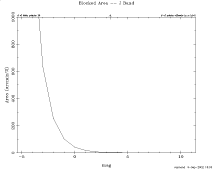
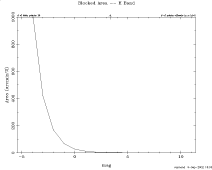

The summed area blanked by all stars in a given magnitude bin:
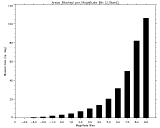


The source density distribution of the stars on an Aitoff projection in each band:

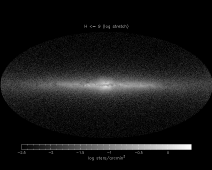
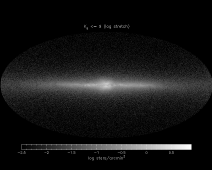
The number of sources and area covered in J band: mag total area cumulative area # srcs bin (deg^2) (deg^2) ======= ===== ========== =============== 0 -4.00 0.0000 0.0000 3 -3.00 0.7470 0.7470 6 -2.00 0.5688 1.3158 23 -1.00 0.8248 2.1406 71 0.00 1.0852 3.2258 251 1.00 1.4318 4.6576 957 2.00 2.4113 7.0689 2455 3.00 2.7879 9.8568 6619 4.00 3.7072 13.5640 23815 5.00 6.8516 20.4156 63977 6.00 11.0280 31.4436 167180 7.00 18.3624 49.8060 429334 8.00 32.0620 81.8680 415895 9.00 24.2968 106.1648 The number of sources and area covered in H band: mag total area cumulative area # srcs bin (deg^2) (deg^2) ======= ===== ========== =============== 3 -4.00 0.5842 0.5842 6 -3.00 0.5841 1.1683 21 -2.00 0.6844 1.8527 60 -1.00 0.9616 2.8143 210 0.00 1.4213 4.2356 740 1.00 2.1558 6.3914 2213 2.00 2.8704 9.2618 6323 3.00 3.9770 13.2388 16353 4.00 5.4842 18.7230 53737 5.00 10.1923 28.9153 136587 6.00 16.1870 45.1023 356468 7.00 28.0327 73.1350 931922 8.00 51.0834 124.2184 910499 9.00 31.9907 156.2091 The number of sources and area covered in K band: mag total area cumulative area # srcs bin (deg^2) (deg^2) ======= ===== ========== =============== 4 -4.00 0.4694 0.4694 6 -3.00 0.2765 0.7459 32 -2.00 0.5250 1.2709 93 -1.00 0.6919 1.9628 296 0.00 1.0472 3.0100 1019 1.00 1.8132 4.8232 3352 2.00 3.0843 7.9075 8130 3.00 4.0778 11.9853 27030 4.00 7.6282 19.6135 74294 5.00 13.0373 32.6508 194354 6.00 22.0641 54.7149 510678 7.00 39.3000 94.0149 1323471 8.00 61.1044 155.1193 1227934 9.00 22.7549 177.8742
Last Updated: 21 Feb 2003
R. Tam - IPAC
J. Carpenter - Caltech